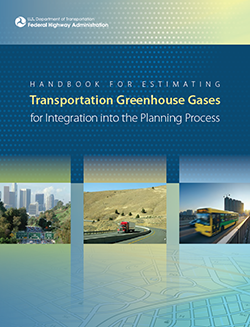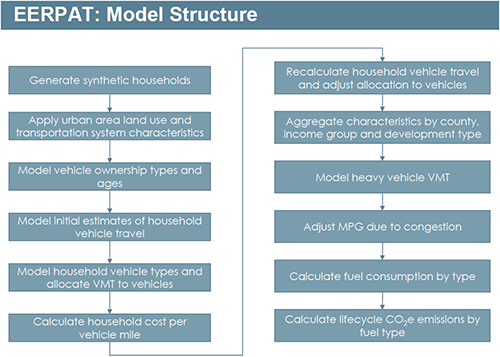
FHWA
Develops Tools to Advance Climate Change Mitigation Strategies
Climate change mitigation strategies are quickly becoming an integral part of transportation planning and decisionmaking for State Departments of Transportation (DOTs) and Metropolitan Planning Organizations (MPOs). With more than one fourth of greenhouse gas (GHG) emissions in the United States originating in the transportation sector, the Federal Highway Administration (FHWA), State DOTs, and MPOs are developing tools that analyze a region’s GHG emissions and can assist in developing policies that help to reduce them.

FHWA’s Handbook for Estimating Transportation Greenhouse Gases for Integration into the Planning Process provides guidance on how to include GHG emissions analysis in the planning process. (Courtesy of FHWA)
To help agencies analyze GHG emissions and construct more effective climate mitigation policies at the State and regional level, the FHWA Office of Planning, Environment, and Realty developed a number of climate change mitigation tools and resources that, taken together, create a comprehensive toolkit. The toolkit is comprised of a GHG transportation planning handbook, a GHG policy modeling tool, a construction and maintenance emissions calculator, and a performance-based planning handbook. This newsletter describes these tools, which can help transportation agencies better incorporate GHG emissions analysis into their planning processes.
Handbook Provides Analytical Tools for Transportation Planners
FHWA developed the Handbook for Estimating Transportation Greenhouse Gases for Integration into the Planning Process, released in March 2013, for State DOTs and MPOs that want to analyze GHG emissions in the planning process at the State or regional level. The handbook provides an overview of several analytical methods that can be used for incorporating GHG emissions information into the transportation planning and climate change mitigation processes. It is intended to serve as a user-friendly, step-by-step guide for organizations of various sizes and technical capabilities.
Using the handbook, practitioners will learn about factors to consider when selecting an approach for analyzing GHG emissions, step-by-step procedures, and common data sources. Practitioners new to the process will be informed of the strengths and limitations of various analytical approaches. The handbook also describes how to develop an inventory for estimating past or current emissions, how to forecast future emissions under different scenarios, and how to conduct analyses of GHG reduction strategies. The handbook directs readers to additional resources and tools, including FHWA’s Energy and Emissions Reduction Policy Analysis Tool and the Construction and Maintenance GHG Emissions Calculator.
New Tool Models GHG Reduction Policy Scenarios

EERPAT
analyzes demographic, travel, land use, and emissions inputs. (Courtesy of FHWA)
Energy and Emissions Reduction Policy Analysis Tool (EERPAT) assists State DOTs and MPOs in analyzing and comparing the effects of different GHG reduction policy scenarios on GHG emissions from the surface transportation sector. FHWA developed this tool to assist agencies with analyzing GHG reduction scenarios and alternatives for use in the transportation planning process as well as in the development of climate action plans and scenario planning exercises. The tool estimates and forecasts the effects of policies on transportation behaviors and the corresponding impact on GHG emissions.
Based on the Oregon Department of Transportation’s (ODOT) Greenhouse Gas Statewide Transportation Emissions Planning Model (GreenSTEP), EERPAT combines elements of a four-step travel-demand model and activity-based forecasting (at the household level) to simulate how travelers would likely respond to various policies. The figure to the right depicts how the model estimates changes in travel demand and emissions, accounting for factors such as changes in vehicle characteristics, generalized travel costs, and congestion. The emissions component of EERPAT includes data taken from the Environmental Protection Agency’s Motor Vehicle Emissions Simulator model.
FHWA is developing a graphical user interface to improve the model’s usability. In addition, Washington, Maryland, Vermont, and Colorado are currently piloting the tool to inform future updates.
GreenSTEP Data Helps ODOT and Portland Metro Shape GHG Emissions Reduction Policies
Using findings from GreenSTEP GHG emissions reduction models, ODOT developed the Statewide Transportation Strategy (STS), which acts as a broad path forward for reducing transportation-related GHG emissions in Oregon. The STS and corresponding short-term implementation plan outline specific implementation programs (e.g., electric vehicles, eco-driving, and road user charge economic analysis) designed to achieve a variety of transportation goals, including GHG emissions reduction.
Portland Metro, the regional government for the Portland metropolitan area, is using GreenSTEP in its Climate Smart Communities Scenarios Project, which is a mandated regional planning effort that will mimic the Oregon STS process. Portland will submit its preferred policy approach for reducing transportation-related GHG emissions to the State in January 2015.
Emissions Calculator Considers GHGs from Transportation Construction and Maintenance
EERPAT takes into account all direct transportation emissions, but it does not calculate those emissions produced by the construction and maintenance of transportation projects. Considering that the impacts of GHG emissions are based on cumulative emissions—the total emissions generated from the construction, operation, and maintenance of transportation projects—it’s important for State DOTs and MPOs to calculate both direct and indirect transportation emissions.
To be released in early fall of 2014, the Construction and Maintenance GHG Emissions Calculator is a spreadsheet tool designed to help analysts of the National Environmental Policy Act (NEPA) and planner estimate the emissions associated with surface transportation infrastructure. The model uses simple inputs (e.g., lane-miles, roadway type) to estimate emissions from materials, construction activities, and facility maintenance. The calculator also estimates the potential emissions reductions from alternative construction and maintenance practices, such as preventive maintenance, alternative paving strategies, and the use of recycled materials.
This information can be useful in supporting a variety of different planning functions that have not traditionally considered infrastructure-related GHGs. For instance, the calculator could help MPO planners address infrastructure emissions across different plan alternatives (e.g., highway-focused, transit-focused, or “fix it first” approaches) and across various NEPA alternatives. This information could also allow analysts to evaluate the life-cycle construction and maintenance emissions of new infrastructure and to calculate the payback periods for these projects. Used together, EERPAT and the emissions calculator produce a complete picture of a State’s or region’s total transportation-related emissions.
Linking GHG Emissions Analyses to Performance-Based Planning
New FHWA Sustainability Report Highlights Climate Change Mitigation Efforts
This summer FHWA will release Advancing a Sustainable Highway System: Highlights of FHWA Sustainability Activities, a report illustrating how FHWA incorporates sustainability into a wide variety of its programs, projects, policies, processes, and partnerships. FHWA is committed to improving the sustainability triple bottom line—the social, economic, and environmental outcomes—of its activities. FHWA has spearheaded numerous efforts to address and advance sustainability ranging from projects to mitigate climate change impacts, to initiatives that promote sustainable pavements and improve safety, to tools to better assess the benefits and costs of transportation investments. The report highlights many of the tools and resources included in this newsletter as well as other climate change mitigation efforts.
The greenhouse gas methods and tools mentioned above can be used to support performance-based planning and programming. FHWA developed A Performance-Based Approach to Addressing Greenhouse Gas Emissions in Transportation Planning to describe considerations for selecting relevant GHG performance measures, techniques for evaluating performance, and approaches for using performance information to support investment choices and enhance decisionmaking. The performance-based approaches outlined in this handbook reinforce FHWA’s commitment to helping State agencies and MPOs make more efficient investments, increase accountability and transparency, and establish outcome-based programs, as outlined in the Moving Ahead for Progress in the 21st Century Act.
FHWA Tools Assist States in Achieving GHG Reduction and Mitigation Goals
The four tools outlined above provide a foundation for State DOTs and MPOs to either begin building or to strengthen existing climate change mitigation strategies in the transportation planning process. By addressing GHG emissions at the beginning of the planning process, States and MPOs can reduce their environmental impact while improving transportation decisionmaking and efficiency at the program level. This approach may also inform the analysis and environmental stewardship needs of project-level decisionmaking.
Contact Information
John Davies
Sustainable Transport and Climate Change Team
Office of Natural Environment
Federal Highway Administration
(202) 366-6039
JohnG.Davies@dot.gov
Diane Turchetta
Sustainable Transport and Climate Change Team
Office of Natural Environment
Federal Highway Administration
(202) 493-0158
Diane.Turchetta@dot.gov
Look What’s New!
- FHWA and the Federal Transit Administration (FTA) recently launched a National Online Dialogue to engage stakeholders in a nationwide discussion on the use of programmatic approaches to conduct environmental reviews for transportation projects. The National Online Dialogue will be open until May 16, 2014. Click here to register and participate.
- In April, FHWA published Statewide Transportation Planning for Healthy Communities. This white paper presents insights and a flexible framework for State DOTs that choose to integrate public health considerations into their transportation planning and decisionmaking. Visit the Transportation Planning for Healthy Communities landing page for more information.
Successes in Stewardship is a Federal Highway Administration newsletter highlighting current environmental
streamlining and stewardship practices from around the country. Click here to subscribe, or call 617-494-3539 for more information.

